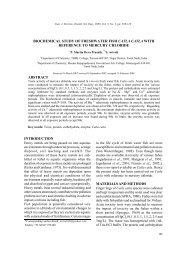Omental and Retroperitoneal Hydatid Cyst: A Case Report
Omental and Retroperitoneal Hydatid Cyst: A Case Report
Omental and Retroperitoneal Hydatid Cyst: A Case Report
Create successful ePaper yourself
Turn your PDF publications into a flip-book with our unique Google optimized e-Paper software.
Sirus et al.a b cFig 3. a-c. <strong>Cyst</strong>ic lesion, thick-walled with mural nodule.abcould have been secondary to shedding from onecyst, probably following a trauma, as the patients reportedan incident of falling from the horse back longago, the released daughter cysts could have formedthe other 2 cysts. Still, this hypothesis cannot be supportedby plausible evidence.E. granulosus infection of the liver frequently producesno symptoms. The right lobe is affected in 60 to85 percent of patients, as was in our case. Significantsymptoms are unusual before the cyst has reached atleast 10cm in diameter. 9 Peritoneal echinococcosisusually goes undetected until cysts are large enoughto produce symptoms. 8,10,11 In our case the patient hadright upper quadrant pain with a cyst that measured5×5 cm on CT scan.Isolated retroperitoneal hydatid cyst is rare <strong>and</strong> it isusually the result of spontaneous, traumatic or surgicalrupture of a primary hepatic cyst. 12,13In the present case, one of the cysts was retroperitoneal,among the left kidney, duodenum <strong>and</strong> abdominalaorta <strong>and</strong> the patient had a history of previoustrauma.The calcification <strong>and</strong> enlargement of the rightseminal vesicle with normal pathologic result in ourpatients could be due to a dead hydatid cyst. Althoughisolated hydatid cyst in a seminal vesicle hasnot been reported previously, in the present case thepossibility for the secondary involvement of seminalvesicles from abdominal hydatid cysts exists <strong>and</strong> thenormal biopsy can be the result of sampling from theadjacent normal tissue. 13 Since no further investigationof the lesion was done after the normal biopsyreport, its true etiology cannot be cleared.Routine laboratory tests, including complete bloodcounts <strong>and</strong> liver function tests, may be abnormal butare nonspecific <strong>and</strong> cannot make a diagnosis. In ourpatient the laboratory findings were all normal.CT scan is the imaging of choice for determiningthe number, size <strong>and</strong> anatomic location of cysts, <strong>and</strong>is also superior to ultrasound in detecting extrahepaticcysts. 7 Imaging findings in hydatid diseasedepend on the stage of the cyst growth. It means,whether the cyst is unilocular, contains daughtervesicles, contains daughter cysts, is partially calcified,or is completely calcified (dead), the imaging defers.So the range of differential diagnosis is wide <strong>and</strong>missed cases are common. In the present case, theunusual location of the cysts <strong>and</strong> the shape of the cystwith thick wall <strong>and</strong> mural nodule on CT, suggesteddifferential diagnoses of pancreatic pseudocyst or necroticlymph nodes probable.Therefore, it is to emphasize that in any cystic lesionin any anatomic location, hydatid cyst should beconsidered at least as a differential diagnosis especiallyin places that hydatid cyst is endemic.Fig 4. The Phatologic feature of the cystsIran. J. Radiol., Summer 2006, 3(4) 219






